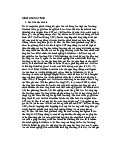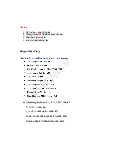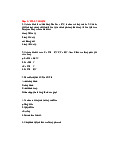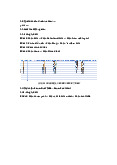







Preview text:
MACECONOMICS (ENGLISH)
3.2*Social policy in the reform period in Vietnam
*1. The Party's policy on social policy in the reform period
*Social policy was mentioned by the Party at the 6th Congress (December 1986)
with the policy: social policy aims to promote all human abilities and take serving
people as the highest goal. This is the Party's initial viewpoint on social policy
during the country's reform period.
*In the following congresses, the Party gradually supplements and perfects its
views and guidelines on social policy. The development of the Party's awareness of
social policy is shown in Resolution No. 15-NQ/TW dated June 1, 2012 "On some
social policy issues in the (2012-2020 period" of the Central Conference Chapter 5, course XI) .
*The resolution advocates focusing on two basic and important groups of policies
in the system of social policies: preferential policies for people with meritorious
services and social security policies.
*The resolution sets the goal: "Improving the material and spiritual life of people
with meritorious services, striving to basically ensure that families of people with
meritorious services have a living standard equal to or higher than the average
living standard of the people (by 2015)." residing in the area; (By 2020), basically
ensure social security for all people, ensuring minimum levels of income,
education, health care, housing, clean water and information and communication,
contributing to gradually increasing income , ensuring the people's safe, equal and happy lives" .
*During the period of innovation, promoting industrialization, modernization and
international integration, the Party's guidelines on social policy are gradually
improved, increasingly expanded, inclusive and diverse. Among them, the
consistent viewpoint is: “realizing progress and social justice; improve the quality
of life and happiness of the people" .
*3.2.1 Create working conditions for people unemployment :
+Labor and employment policies are implemented effectively, contributing to
building the labor market, creating jobs, increasing income and improving the
quality of life of workers , that’s why this is a impressive by policy of government.
+Every year, the whole country has (1.5-1.6 million people getting jobs); In the 2
years (2020-2021) alone, due to the impact of the Covid-19 pandemic, this number
decreased to about (1.3 million people/year) , but beside that the government
always have any things to solve for that , specially about the job for popular .
+The general unemployment rate remains stable (at below 3%, the urban
unemployment rate is below 4%) , that’s a best amazing when we talk about the
how to solve any problem for popular and know have to do something to bring
back the prounds of time before .
+Hunger eradication and poverty reduction policies have been promoted
throughout the reform period, with the cooperation of the entire political system
and people of all walks of life , yes of course because the policy was creative by
goverment always help and improve any problem when it’s stand up and face to face difficults problems .
+Vietnam's poverty reduction work has achieved impressive achievements, highly
appreciated by the international community , all of that it’s was complete by the policy of government .
+Since 2011, Vietnam officially entered the group of middle-income countries.
Every year, the country's poverty rate decreases by (about 1%-1.5%/year); By
2021, (it will decrease to 2.23%) , we’re so pround of about the gold time because
it’s was impressive to be solve about the economic .
+The average income of poor households is increasing: (in 2020 it will be 2.3
times higher than in 2015, 3.5 times higher than in 2010) , so we and government
should have better another sollutions and another policy to help for that .
*3.2.2 Unemployment insurance policy:
+Social insurance and unemployment insurance policies are becoming more
complete, multi-dimensional, fair and open; Step by step affirm and promote its
role as a pillar of social security policy , this is one of policy of government .
+The number of participants in forms of social insurance is increasingly expanding
and increasing, reaching (16.2 million people in 2020) and (16.6 million people in
2021) , this is the exactly answer number on the system .
+Of which, the number of people participating in voluntary insurance reached
nearly (1.5 million people) , that’s a good volunteers to be solve for that .
+Subjects eligible for regular benefits have been expanded to include: disabled
people, orphans, the elderly without support... These subjects are entitled to regular
social relief benefits from grassroots authorities, receive support for medical
examination and treatment, free education, vocational training and job creation... In
case there is no caregiver or sponsor, they will receive centralized care in social
protection facilities , beside that the government need to have a some another
policy to save for this human , that’s important misson they have to .
+The number of people receiving regular social assistance has increased over the
years: in 2020 it reached 3.042 million people (covering more than 3% of the
population), by 2021 it increased to 3.25 million people (covering 3.5% of the
population). number); Of which, (over 55% are elderly) , and older man in social
should be help because they worthy to care and save in difficult time specially
family or neighbor no have or no care about them .
+The unexpected support policy has covered target groups in need of support,
ensuring people's lives when facing risks and natural disasters , absolutely that’s
problem of course because in life always have an accident about the natural
weather and human need to face to that , so government have to support them to overcome in this challenge .
+In particular, in the two years (2020-2021), to ensure social security against the
impact of the (Covid-19) pandemic, the State has issued many policies to promptly
support people , so in special time in Covid19 they have to creative many solution
or policy to safe for people .
+ such as: Resolution No. 42/NQ- CP dated April 9, 2020 "on measures to support
people facing difficulties due to the Covid-19 pandemic", this problem is absolutely .
+Resolution No. 68/NQ-CP dated July 1, 2021 "on policies to support workers and
employers facing difficulties due to the Covid-19 pandemic", that’s as the same as like as above .
+Decision No. 08/2022/QD-TTg dated March 28, 2022 "on implementing the
housing rental support policy for employees" and Policies to support orphans due
to Covid-19, support Covid-19 patients... safe them without another help from
policy of government or some one else .
*3.3 ANOTHER POLICY WERE COMPLETELY
+Education: completed before the deadline for universal education from
preschool (5 years old) to middle school. The literacy rate of people aged (15 and
over reached 97.85%). The rate of trained workers reached (70.25%) , yes this
prounds things of policy from them to help people specially kids to overcome from no knowledge .
+Health: the basic health system is complete in terms of infrastructure and human
resources; In which, priority will be given to poor districts and communes with
special difficulties. The rate of malnourished and underweight children under 5
years old decreased from (16.2% in 2012 to 12.5% in 2020). Preventive medicine
has been strengthened. The rate of children vaccinated is over (90%) , this is a best
answer we ever have because their power and their time another from them it’s was help people .
+Minimum housing:
*By the end of 2020, the whole country has supported accommodation for
(648,000 poor rural households), (17,200 households to prevent storms and floods
in the Central region); (52,000 households in flooded areas of the Mekong Delta);
(Supported 323,000 houses for the poor and people in difficult circumstances from
socialized sources) , beside that they could be have done somethings big to solve for that problem like this .
+Housing conditions for the poor, low-income people in urban areas, housing for
workers in industrial zones and students have gradually improved ,that’s a good
sollutions we need to see it .
+Regarding ensuring clean water:
*The Government has focused resources on developing rural clean water supply
networks, especially in remote areas and areas with difficult socio-economic
conditions , about the technology if they have a rich economic , I think they should have to join for this .
+In the period (2012-2021), the proportion of the rural population using hygienic
water increased from (80.3% to 90%); The proportion of the rural population using
clean water meeting national standards increased from (38.7% to 54%) , in that
problem they should upgrade more good sollutions to help for this .
+ Access to information:
*since 2016, 100% of mountainous, remote, border and island communes have communal radio stations .
*The grassroots information and communication system is prioritized for
investment, ensuring information about the Party's guidelines and guidelines and
the State's policies and laws to the people ,
*The gap in ensuring information and enjoying information between people in
different regions has been shortened.
*In general, the social policy system in the reform period, especially after 10 years
of implementing Resolution No. 15/NQ-TW of the 5th Central Conference, term
XI (2012-2022), has ensured fairness, comprehensive, comprehensive, approaching
international standards; basic guarantee of people's welfare rights; improve
material and spiritual life, gradually meeting the aspirations of all classes of
people. That’s why every information enough and could solve that excellent .
*Achievements in implementing social policies have ensured "economic growth
associated with progress, equity, and society", contributing to promoting economic
development, political and social stability.
*3.2.3 SOME SOLLUTIONS :
+To solve the problems raised and to more effectively implement social policies in
the coming years, the 13th Party Congress affirmed the need to: "Fully recognize
and ensure socialist orientation in the social policies. Strengthen social
development management, ensure progress and social justice, sustainability in
social policies, especially social welfare, social security, and human security.
+Deploy synchronously and comprehensively economic goals, progress, social
justice and the environment, and on that basis, innovate and allocate reasonable
resources to improve the effectiveness of social development.
+Building and implementing synchronously institutions and social development
policies, managing sustainable and harmonious social development" .
+The Congress proposed basic directions and solutions: Develop appropriate
social policies and social development management; linking economic
development policies with social policies.
+Complete and well implement laws and policies for people with meritorious
services based on the resources of the State and society.
+ Reform salary policy in a direction that approaches the price of labor in the
market, commensurate with economic growth rate, labor productivity growth rate,
ensuring the principle of distribution according to labor , creating motivation to
improve productivity and work efficiency.
+ Develop a synchronous, modern, flexible, unified, integrated and effective labor market.
+ Develop a comprehensive social security system, moving towards covering
policies to prevent, reduce and overcome risks for people, ensuring support for vulnerable groups.
+ Develop and effectively implement population and development policies;
proactively adapt to the trend of population aging .
*Based on the basic orientations outlined by the 13th Party Congress, it is
necessary to focus on the following specific issues:
+Firstly , continue to adjust and supplement the social policy system in an
effective, inclusive, comprehensive, sustainable direction, promptly institutionalize
the Party's policies, in accordance with the requirements and tasks of the Party. new situation.
+Specifically: it is necessary to research and amend the Employment Law, Health
Insurance Law, Social Insurance Law, and Ordinance on Incentives for
Meritorious People in accordance with the country's development orientation in the new context.
+The Government needs to continue to issue decrees to guide relevant
departments, ministries, branches and levels, branches and localities to effectively implement social policies.
+Building a legal framework on social policy towards strengthening the
connection, coordination, and synchronization between social policy and legal
tools; between social policy and related economic policies.
+Timely and regularly review, amend and abolish policies that are no longer appropriate.
+Promote the application of technology in social policy administration and
management, helping to monitor, manage and implement policies in localities accurately and effectively.
+Second : strengthen the leadership, direction and management of party
committees and authorities at all levels, promote the strength of the entire political
system, create consensus of the entire society in implementing programs, policies
for people with meritorious services, ensuring social security.
+Promote propaganda and dissemination of laws, raise awareness of all levels,
sectors, organizations and people in implementing social policies.
+Third : continue to focus on two pillars of social policy: policy for people with
meritorious services and social security policy.
+Complete the household database system, personal identification number and
social security index set to improve the efficiency of management, monitoring and
evaluation of the implementation of social security policies.
+It is necessary to pay attention to the subjects "in the middle between social
insurance and social benefits" (people with a below average standard of living,
without social insurance, but not yet classified as poor, so they cannot receive
benefits). receive social benefits); informal sector workers and vulnerable groups.
+Promoting the role of the middle class in solving social security and welfare issues.
+Changing perceptions about the elderly in the direction of both caring for and
promoting the role and contribution of the elderly to society.
+Increase investment in social security and recognize it as a source of growth.
+Fourth : pay special attention to implementing specific poverty reduction
policies and solutions for disadvantaged areas and ethnic minority areas.
+Mobilize the support of the entire society, encourage and support the poor and
poor areas, and improve the endogenous capacity of people to escape poverty sustainably.
+The goal of Vietnam's social policy for the period 2020-2030, with a vision to
2045, is to target the entire population, implementing inclusive and comprehensive
policies; including, creating qualitative changes in the implementation of policies
towards people with meritorious services and social security policies; create
development opportunities for people, leaving no one behind; building a
progressive socialist society; for the goal of rich people, strong country,
democracy, fairness and civilization. _ END_ Link :
http://lyluanchinhtri.vn/home/index.php/tin-tuc/item/4724-chinh-sach-xa-hoi-
trong-thoi-ky-doi-moi-o-viet-nam.html .




